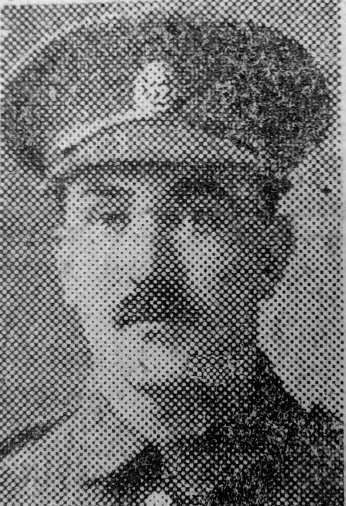L/Cpl
Isaiah Fisher
Information about birth
|
Date of birth: 07/04/1887 |
|
Place of birth: Ardsley, Yorkshire, England, United Kingdom |
General information
|
Last known residence: 13 Middlecliff Lane, Little Houghton, Yorkshire, England, United Kingdom |
|
Profession: Coal miner |
|
Religion: Wesleyan |
Army information
|
Country: England, United Kingdom |
|
Force: British Expeditionary Force |
|
Rank: Lance Corporal |
|
Service number: 13/339 |
|
Enlistment date: 25/09/1914 |
|
Enlistment place: Barnsley, Yorkshire, England, United Kingdom |
|
Units: — York & Lancaster Regiment, 6th Bn. (Last known unit) |
Information about death
|
Date of death: 09/10/1917 |
|
Place of death: Tracas Farm, Belgium |
|
Cause of death: Killed in action (K.I.A.) |
|
Age: 30 |
Memorial
|
Tyne Cot Memorial Panel: 126 A |
Distinctions and medals 2
|
British War Medal Medal |
|
Victory Medal Medal |
Points of interest 4
| #1 | Place of birth | ||
| #2 | Last known residence | ||
| #3 | Enlistment place | ||
| #4 | Place of death (approximate) |
My story
Isaiah Fisher, a miner from Little Houghton, near Barnsley, volunteered in September 1914. He served at home with the York and Lancaster Regiment, 13th Battalion (Barnsley) till December 1915, when the battalion went to Egypt. In March 1916 the 13th Battalion was deployed on the Western Front. Isaiah was wounded in July 1916. After a brief intermission back home he was redeployed to France in 1917. By the fall of 1917, Isaiah was a Lance Corporal with the 6th Battalion York and Lancaster.
On 9 October 1917, during the Battle of Poelcapelle, the 6th York and Lancaster, was in position between Gloster Farm and Terrier Farm, South of Poelcapelle. Their goal; the German positions at Tracas Farm. At the start of the attack, the first wave of the battalion was allowed to move through the battalion’s outposts. When the remaining lines tried to follow, they were held up by heavy machinegun fire. The entire first wave had been cut off in No man’s land. In the course of the day German counter-attacks, forced the attackers back towards their starting lines. The men of the first wave were either killed or taken prisoner.
The Battle of Poelcapelle was an utter failure. Constant shelling had destroyed the irrigation channels. Whenever it rained the water had no place to go and the operation area had turned into a bog. There was inadequate artillery support, as the guns got stuck in the mud. So the pillboxes and barbed wire of the well-defended German line were largely unscathed. Nevertheless the attack went ahead as planned.
Isaiah, 30, went missing on 9 October 1917. Leaving behind a wife, Alice, and six children. The youngest was barely a year old.
On 9 October 1917, during the Battle of Poelcapelle, the 6th York and Lancaster, was in position between Gloster Farm and Terrier Farm, South of Poelcapelle. Their goal; the German positions at Tracas Farm. At the start of the attack, the first wave of the battalion was allowed to move through the battalion’s outposts. When the remaining lines tried to follow, they were held up by heavy machinegun fire. The entire first wave had been cut off in No man’s land. In the course of the day German counter-attacks, forced the attackers back towards their starting lines. The men of the first wave were either killed or taken prisoner.
The Battle of Poelcapelle was an utter failure. Constant shelling had destroyed the irrigation channels. Whenever it rained the water had no place to go and the operation area had turned into a bog. There was inadequate artillery support, as the guns got stuck in the mud. So the pillboxes and barbed wire of the well-defended German line were largely unscathed. Nevertheless the attack went ahead as planned.
Isaiah, 30, went missing on 9 October 1917. Leaving behind a wife, Alice, and six children. The youngest was barely a year old.
Sources 3
|
6 Battalion York and Lancaster Regiment (The National Archives, Kew (TNA), WO-95-1809-5). https://www.nationalarchives.gov.uk/ Sources used |
|
Census Returns of England and Wales, 1911 (The National Archives, Kew (TNA), RG14). https://www.nationalarchives.gov.uk/ Sources used |
|
War Office: Soldiers’ Documents, First World War (The National Archives, Kew (TNA), WO 363). https://www.nationalarchives.gov.uk/ Sources used |
More information 2
|
Commonwealth War Graves Commission Database https://www.cwgc.org/find-records/find-war-dead/casualty-details/1631954 |
|
Namenlijst (In Flanders Fields Museum) https://namenlijst.org/publicsearch/#/person/_id=068ebed0-48cd-458c-b9f8-30819ce487db |
